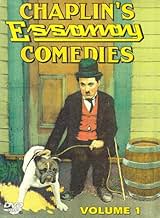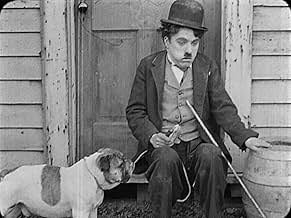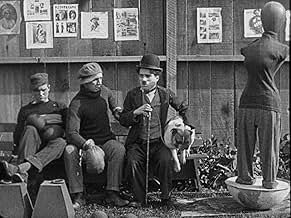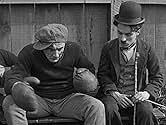PUNTUACIÓN EN IMDb
6,7/10
2,9 mil
TU PUNTUACIÓN
Añade un argumento en tu idiomaWith his bulldog, Charlie finds a good luck horseshoe as he passes a boxing camp looking for someone who can take a beating. With the horseshoe in his glove, Charlie wins and earns a fight a... Leer todoWith his bulldog, Charlie finds a good luck horseshoe as he passes a boxing camp looking for someone who can take a beating. With the horseshoe in his glove, Charlie wins and earns a fight against the world champion.With his bulldog, Charlie finds a good luck horseshoe as he passes a boxing camp looking for someone who can take a beating. With the horseshoe in his glove, Charlie wins and earns a fight against the world champion.
- Dirección
- Guión
- Reparto principal
Bud Jamison
- Bob Uppercut - Champion
- (sin acreditar)
Gilbert M. 'Broncho Billy' Anderson
- Enthusiastic Fan
- (sin acreditar)
Billy Armstrong
- Sparring Partner
- (sin acreditar)
Lloyd Bacon
- Second Sparring Partner
- (sin acreditar)
- …
Bill Cato
- First Sparring Partner
- (sin acreditar)
- …
Frank Dolan
- Second Stretcher Bearer
- (sin acreditar)
W. Coleman Elam
- Bit Role
- (sin acreditar)
Eddie Fries
- Bit Role
- (sin acreditar)
Daniel P. Kelleher
- Second Cop
- (sin acreditar)
Paddy McGuire
- Sparring Partner
- (sin acreditar)
Edna Purviance
- Trainer's Daughter
- (sin acreditar)
Jess Robbins
- Bit Role
- (sin acreditar)
Carl Stockdale
- Sparring Partner
- (sin acreditar)
Ben Turpin
- Ringside Vendor
- (sin acreditar)
Ernest Van Pelt
- Spike Dugan
- (sin acreditar)
Leo White
- Crooked Gambler
- (sin acreditar)
Reseñas destacadas
I saw the 20 minutes version. It ends with his bulldog entering the ring biting and Charles Chaplin knocking out his opponent in Round 20. I guess it's missing the romantic ending. I can understand that. This version is strictly a slapstick movie.
I like quite a lot of the slapstick. Of course, there is nothing funnier than his boxing sequence in 'City Lights' (1931). Here he's trying out several things. When he's boxing fodder, he puts a horseshoe into his glove. Then during the long boxing match, he's doing a lot of what would recognizable to most people who's seen the boxing match in 'City Lights'.
I like quite a lot of the slapstick. Of course, there is nothing funnier than his boxing sequence in 'City Lights' (1931). Here he's trying out several things. When he's boxing fodder, he puts a horseshoe into his glove. Then during the long boxing match, he's doing a lot of what would recognizable to most people who's seen the boxing match in 'City Lights'.
The real leap forward that Charlie Chaplin made in screen comedy, the thing that put him ahead of his peers, was that he staged his comedy within a straight and serious world. His first two Keystone pictures had little plot but allowed his little tramp to interact (chaotically) with a realistic environment, albeit with a handful of supporting comedy characters thrown in. With the Champion he moved on to develop stronger story lines which were not funny in themselves, but which gave the tramp a world to be funny in.
The set-up of an up-and-coming boxer who fights his way to the top, is then bribed into throwing a fight and has to choose between his integrity and the payoff was an established cliché even back then. This well-known sequence of events allows Chaplin to mess around with stereotypes or subvert conventions. For a start, there is the fact that Charlie is a scrawny little feller, who essentially cheats his way to the championship. Then there's the farcical training routine, which Chaplin cross-cuts with the opponents more serious routine to give it more comedy impact, followed by the tramp's nonchalant seeing-off of Leo White's over-the-top sinister villain.
Throughout Chaplin is showing more confidence in his staging and arrangements. He allows himself to become a more marginal figure in some sequences – for example when Spike Duggan is knocking out one challenger after another, Charlie isn't doing very much, and is off-screen half the time, but it's his reactions to the growing number of defeated men that is funny. The other characters simply act naturally, whereas Chaplin is the originator of all the comedy.
In Chaplin's previous picture, A Night Out, he came dangerously close to becoming a double-act with Essanay's resident comic Ben Turpin. A large part of Chaplin's humour was based on reacting to other comedy characters, so he needed to have his supporting cast of burly bullies and pompous twerps to antagonise. However in the Champion you can see he is being careful not to let any of them have too much screen time. Although Bud Jamison, Leo White and Ernest van Pelt all do a great job, each of them is a walk-on, walk-off character; none of them shares the picture with Charlie. Ben Turpin has a tiny part as a vendor, but even in this one-shot role he manages to violate Chaplin's rule of the tramp being at the comedic centre of attention, stealing the laughs as he scrambles over the crowd to reach a customer. This would be Turpin's last picture with Chaplin.
And now, we finish with the all-important statistic – Number of kicks up the arse: 1 (1 for, 0 against)
The set-up of an up-and-coming boxer who fights his way to the top, is then bribed into throwing a fight and has to choose between his integrity and the payoff was an established cliché even back then. This well-known sequence of events allows Chaplin to mess around with stereotypes or subvert conventions. For a start, there is the fact that Charlie is a scrawny little feller, who essentially cheats his way to the championship. Then there's the farcical training routine, which Chaplin cross-cuts with the opponents more serious routine to give it more comedy impact, followed by the tramp's nonchalant seeing-off of Leo White's over-the-top sinister villain.
Throughout Chaplin is showing more confidence in his staging and arrangements. He allows himself to become a more marginal figure in some sequences – for example when Spike Duggan is knocking out one challenger after another, Charlie isn't doing very much, and is off-screen half the time, but it's his reactions to the growing number of defeated men that is funny. The other characters simply act naturally, whereas Chaplin is the originator of all the comedy.
In Chaplin's previous picture, A Night Out, he came dangerously close to becoming a double-act with Essanay's resident comic Ben Turpin. A large part of Chaplin's humour was based on reacting to other comedy characters, so he needed to have his supporting cast of burly bullies and pompous twerps to antagonise. However in the Champion you can see he is being careful not to let any of them have too much screen time. Although Bud Jamison, Leo White and Ernest van Pelt all do a great job, each of them is a walk-on, walk-off character; none of them shares the picture with Charlie. Ben Turpin has a tiny part as a vendor, but even in this one-shot role he manages to violate Chaplin's rule of the tramp being at the comedic centre of attention, stealing the laughs as he scrambles over the crowd to reach a customer. This would be Turpin's last picture with Chaplin.
And now, we finish with the all-important statistic – Number of kicks up the arse: 1 (1 for, 0 against)
It seems natural that at the very start of Chaplin's career he should make a movie in which he plays a grossly unqualified boxer who succeeds by sneaking horse shoes into his gloves. I only wonder why it didn't happen even earlier. He passes a sign saying that sparring partners are wanted, people who know how to take a punch, and heads in. We see him grow increasingly concerned as one guy after another, all bigger and stronger than him, get up to fight and return in a state of dazed semi-consciousness.
A lot of times when I watch these early comedies from Chaplin, I get the feeling that he is often trying to create at least a mildly engaging story throughout which he can throw in a lot of kicking and punching scenes, but in this movie it's the kicking and punching the drives the plot, giving the film an unusually honest feel.
High-energy physical slap-stick is what Chaplin did best at that time, and smacking around a huge mountain of a man while he dances carelessly around as only he can is certainly a treat to watch. And the climactic battle between Charlie and the meaty Bob Uppercut (or Young Hippo, depending on which cannibalized version you may see) is well-acted and fun.
Mack Sennett like his comedies to be fast paced and high energy, without too much time wasted on things like characterization or even story. But in The Champion, Chaplin proves that we can have well-developed characters, an easily discernible story, and still have enough action and solid slap-stick to keep the shorter attention spanned audience members entertained. This is definitely one of the best short comedies that Chaplin had made up to that point.
A lot of times when I watch these early comedies from Chaplin, I get the feeling that he is often trying to create at least a mildly engaging story throughout which he can throw in a lot of kicking and punching scenes, but in this movie it's the kicking and punching the drives the plot, giving the film an unusually honest feel.
High-energy physical slap-stick is what Chaplin did best at that time, and smacking around a huge mountain of a man while he dances carelessly around as only he can is certainly a treat to watch. And the climactic battle between Charlie and the meaty Bob Uppercut (or Young Hippo, depending on which cannibalized version you may see) is well-acted and fun.
Mack Sennett like his comedies to be fast paced and high energy, without too much time wasted on things like characterization or even story. But in The Champion, Chaplin proves that we can have well-developed characters, an easily discernible story, and still have enough action and solid slap-stick to keep the shorter attention spanned audience members entertained. This is definitely one of the best short comedies that Chaplin had made up to that point.
'The Champion' is a nice short film by Charlie Chaplin and of course with Charlie Chaplin. Watching him I always admire his skills. I don't know if you can call it acting but whatever you call it he is great with it. This short starts as a real story but soon it can come to the moment where Chaplin can show his skills. This time in a boxing contest and the preparation before it. There are some very funny moments and most of it was not that predictable. That is the case very often in the shorts of Charlie Chaplin but not so much in this one. I also liked the way the music played together with the performances, it made the whole thing funnier. Definitely worth a watch.
Charlie Chaplin in the prize ring; his admirers will chuckle at the bare thought, and roar when they see the picture. The scenes in the training quarters are a steady laugh, but when Charlie faces his opponent in the roped arena, the fun is more than doubled. There have, doubtless, been burlesque boxing matches ever since the birth of the drama, but this one knocks them all out. It is a three-round "go" that grows in excitement and hilarity at every blow struck. While it must be admitted that Charlies wins the championship on a foul (with the help of his bull dog), everyone will be delighted with the result. A two-reel side-splitter. - The Moving Picture World, March 27, 1915
¿Sabías que...?
- CuriosidadesThe film was restored in 2014 through the Chaplin Essanay Project thanks to the financial support of the Niles Essanay Silent Film Museum.
- ConexionesEdited into Chase Me Charlie (1918)
Selecciones populares
Inicia sesión para calificar y añadir a tu lista para recibir recomendaciones personalizadas
Detalles
- Fecha de lanzamiento
- País de origen
- Sitios oficiales
- Idiomas
- Títulos en diferentes países
- Charlot, boxeador
- Localizaciones del rodaje
- Empresa productora
- Ver más compañías en los créditos en IMDbPro
- Duración
- 31min
- Color
- Mezcla de sonido
- Relación de aspecto
- 1.33 : 1
Contribuir a esta página
Sugerir un cambio o añadir el contenido que falta

































